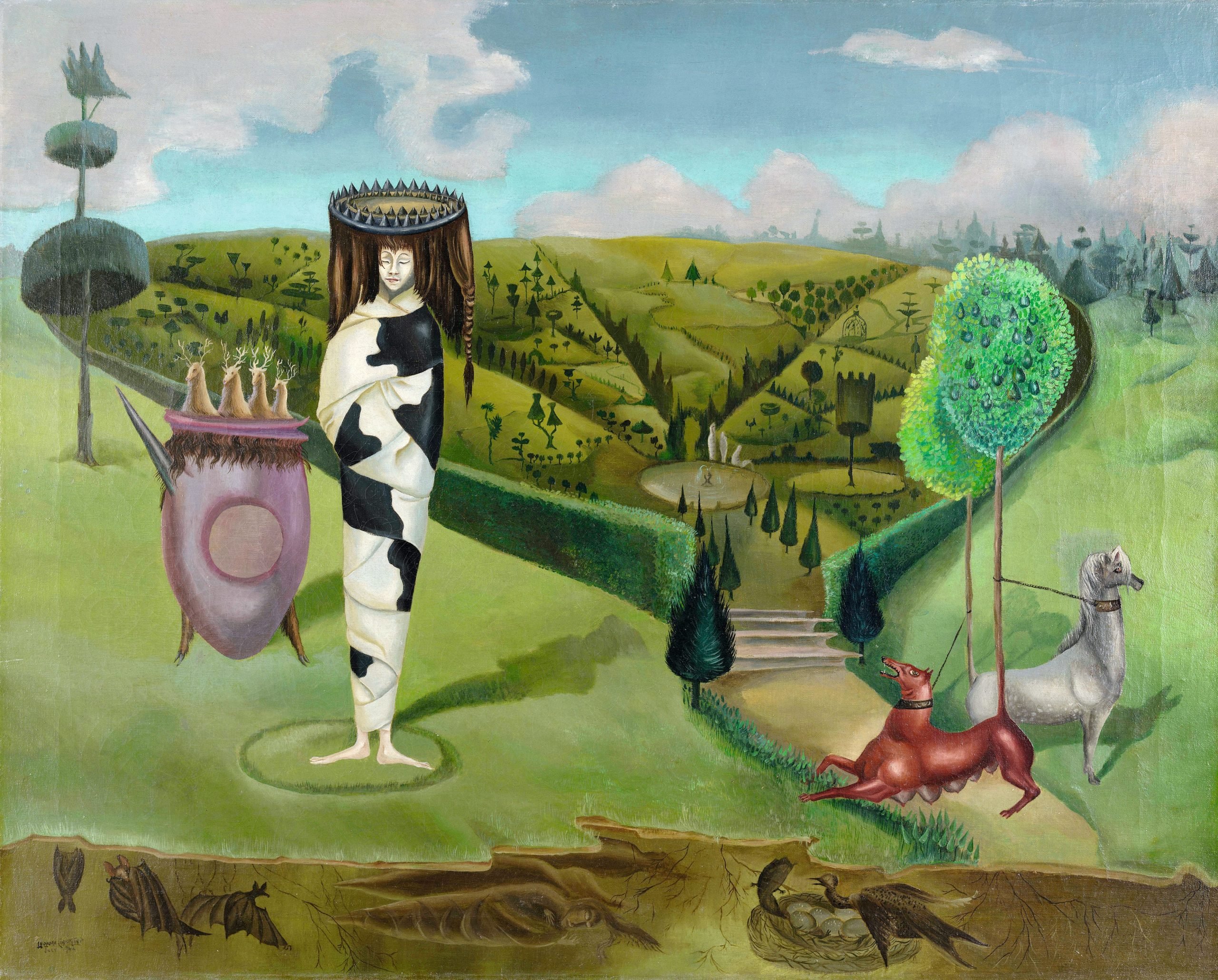
Between the rise of artificial intelligence and the proliferation of “fake news,” living in the 21st-century can sometimes feel a bit surreal. That is why there is perhaps no better time to revisit the 20th century’s Surrealism movement, never mind that 2024 marks 100 years since the publication of André Breton’s pivotal Manifesto of Surrealism in which the French writer and poet called for a new kind of art that is guided by the unconscious and “free from any control by reason.”
To celebrate the centenary of what became a huge cultural movement that still influences artists today, the Centre Pompidou in Paris has mounted a sprawling multidisciplinary exhibition that not only showcases the French roots of Surrealism, but its global reach. Curated by Didier Ottinger and Marie Sarré, the show features over 500 artworks and objects, ranging from paintings, drawings to sculptures, and poems to manuscripts.
René Magritte, Les valeurs personnelles, (1952). San Francisco Museum of Modern Art, purchase through a gift of Phyllis C. Wattis © San Francisco Museum of Modern Art/Photograph Katherine Du Tiel © Adagp, Paris, 2024.
Inspired by the labyrinthine structure of Surrealist exhibitions in the past, visitors follow the exhibition through a spiral layout. On special loan from the Bibliothèque nationale de France, the original manuscript of Breton’s Manifeste du surréalisme is the starting point to the exhibition, with a surrounding audiovisual installation that explores the origins and significance of the manifesto, setting the dreamlike tone for the rest of the show.
Breton was influenced by the works of Sigmund Freud, particularly the ideas surrounding the unconscious mind, dreams, and free association. He sought to create a new art movement that explored these ideas, stating, “I believe in the future resolution of these two states, dream and reality, which are seemingly so contradictory, into a kind of absolute reality, a surreality.”
Installation view of “Surrealism” at Centre Pompidou. © CG Pompidou, J. Rodriguez-Garcia.
The exhibition layout is divided into 13 thematic sections, each exploring different facets of Surrealism. These range from the literary influences that shaped the movement, such as the works of Lautréamont and Lewis Carroll, to the mythical and fantastical elements that became central to Surrealist imagery—dreams, the philosopher’s stone, and forests, amongst many more. Reality and fantasy have been blurred within these exhibition walls, creating a space where the ordinary merges into the extraordinary.
In true Surrealist fashion, the exhibition features a wide range of media, including paintings, drawings, films, photographs, and literary documents. Many iconic works are on display, loaned from international collections. These include Salvador Dalí’s The Great Masturbator from Madrid’s Museo Reina Sofía, René Magritte’s Personal Values from the San Francisco Museum of Modern Art, Max Ernst’s The Large Forest from the Kunstmuseum in Basel, and Joan Miró’s Dog Barking at the Moon from the Philadelphia Museum of Art. The works provide a comprehensive overview of the movement’s diversity, in styles and themes.
Salvador Dali, Visage du grand masturbateur, (1929). Museo Nacional Centro de Arte Reina Sofía, Madrid Legado Salvador Dalí, 1990 © Photographic Archives Museo Nacional Centro de Arte Reina Sofía © Salvador Dalí, Fundació Gala-Salvador Dali / Adagp, Paris 2024.
In addition to showcasing well-known male artists, the exhibition spotlights the long-overlooked contributions of women to Surrealism, mirroring a wider trend both in museums and the art market. To wit: Just this spring, Leonora Carrington’s Les Distractions de Dagobert (1945) set an auction record for the Surrealist painter when it sold for $ 28.5 million at Sotheby’s, obliterating the artist’s previous record of $3.3 million set just two years ago.
At the Pompidou, Carrington’s Green Tea (1942), a landscape painting featuring strange, mythological creatures and floating figures set against a verdant green pasture, among other works, is featured alongside works by contemporaries Remedios Varo, Dora Maar, Ithell Colquhoun, and Dorothea Tanning, illustrating the critical role women played in shaping the movement.
Remedios Varo, Papilla estelar (1958). Colección FEMSA © FEMSA Collection © Adagp, Paris, 2024.
According to curator Marie Sarré, the show is meant to show “Surrealism in all of its diversity.” That also includes highlighting the global scope of the movement. When the Centre Pompidou last held a major exhibition on Surrealism, in 2002, it was positioned as an essentially European movement. The current show charts its expansion beyond Europe to the Americas, Asia, and Africa, and documents how artists from around the world engage with Surrealist ideas. Works by Tatsuo Ikeda from Japan, Helen Lundeberg from the United States, Rufino Tamayo from Mexico, and Wilhelm Freddie from Denmark demonstrate how Surrealism’s core principles—challenging rationality, embracing the unconscious, and exploring alternative realities—resonated with artists from vastly different cultural backgrounds.
Installation shot of “Surrealism” at Centre Pompidou. © CG Pompidou, J. Rodriguez-Garcia.
The exhibition also examines the political dimensions of Surrealism. From its early days, the movement was deeply engaged with the political struggles of its time, opposing colonialism and totalitarianism. This activist spirit is reflected in many of the works on display, underscoring the Surrealists’ commitment to both artistic and social revolution.
The exhibition will also travel internationally after its run in Paris to the Royal Museums of Fine Arts of Belgium in Brussels, the Fundación MAPFRE in Madrid, the Kunsthalle in Hamburg, and the Philadelphia Museum of Art. Each venue will offer its own interpretation of the movement, tailored to local cultural and historical contexts.
“Surrealism” is on view until January 13, 2025, at the Centre Pompidou, Paris.